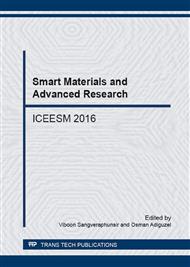p.3
p.7
p.12
p.17
p.22
p.27
p.32
p.37
p.46
The Influence of Nitrogen Plasma on Crystalline Structure and Optical Properties
Abstract:
In this research, zinc oxide (ZnO) films were prepared by thermal evaporation method at temperature between 400-600°C for 60 min. Then, ZnO films were deposited by nitrogen cold plasma technique. The power, frequency and voltage of plasma generated at 100 W, 50 KHz and 5 KV, respectively. These films were deposited by plasma deposition for 15-60 min. The aim of this research is to study the effect of nitrogen plasma on the crystalline structure and optical properties of ZnO film. Crystalline structure, elemental compositions, morphological and optical properties were characterized by using X-ray diffraction (XRD), energy dispersive x-ray spectroscopy (EDS), scanning electron microscopy (SEM) and UV-VIS spectrophotometer, respectively. It was found that the ZnO films preparation via thermal evaporation method at temperature of 500°C showed the highest crystalline with hexagonal structure. After plasma deposition for 15, 30 and 60 min, ZnO films were amorphous. Optical transmittance values decreased and the optical band gap decreased from 3.14 to 3.06 eV with increasing in the plasma time.
Info:
Periodical:
Pages:
22-26
Citation:
Online since:
January 2017
Authors:
Keywords:
Price:
Сopyright:
© 2017 Trans Tech Publications Ltd. All Rights Reserved
Share:
Citation:


